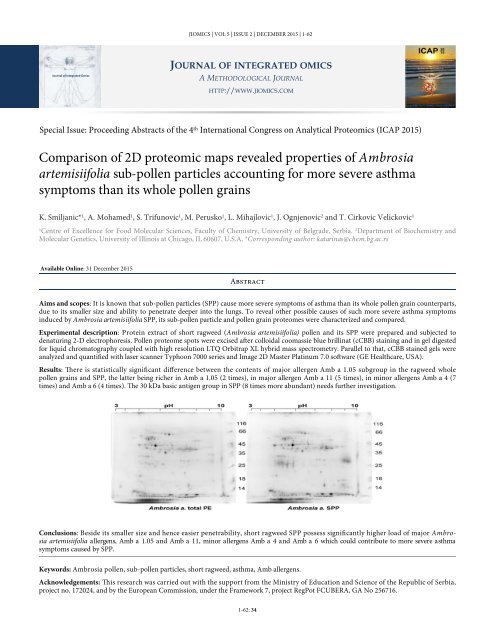JIOMICS
JIOMICS Internacional
JIOMICS Internacional
You also want an ePaper? Increase the reach of your titles
YUMPU automatically turns print PDFs into web optimized ePapers that Google loves.
<strong>JIOMICS</strong> | VOL 5 | ISSUE 2 | DECEMBER 2015 | 1-62<br />
JOURNAL OF INTEGRATED OMICS<br />
Journal of Integrated Omics<br />
A METHODOLOGICAL JOURNAL<br />
HTTP://WWW.<strong>JIOMICS</strong>.COM<br />
Special Issue: Proceeding Abstracts of the 4 th International Congress on Analytical Proteomics (ICAP 2015)<br />
Comparison of 2D proteomic maps revealed properties of Ambrosia<br />
artemisiifolia sub-pollen particles accounting for more severe asthma<br />
symptoms than its whole pollen grains<br />
K. Smiljanic* 1 , A. Mohamed 1 , S. Trifunovic 1 , M. Perusko 1 , L. Mihajlovic 1 , J. Ognjenovic 2 and T. Cirkovic Velickovic 1<br />
1<br />
Centre of Excellence for Food Molecular Sciences, Faculty of Chemistry, University of Belgrade, Serbia. 2 Department of Biochemistry and<br />
Molecular Genetics, University of Illinois at Chicago, IL 60607, U.S.A. *Corresponding author: katarinas@chem.bg.ac.rs<br />
Available Online: 31 December 2015<br />
Abstract<br />
Aims and scopes: It is known that sub-pollen particles (SPP) cause more severe symptoms of asthma than its whole pollen grain counterparts,<br />
due to its smaller size and ability to penetrate deeper into the lungs. To reveal other possible causes of such more severe asthma symptoms<br />
induced by Ambrosia artemisiifolia SPP, its sub-pollen particle and pollen grain proteomes were characterized and compared.<br />
Experimental description: Protein extract of short ragweed (Ambrosia artemisiifolia) pollen and its SPP were prepared and subjected to<br />
denaturing 2-D electrophoresis. Pollen proteome spots were excised after colloidal coomassie blue brillinat (cCBB) staining and in gel digested<br />
for liquid chromatography coupled with high resolution LTQ Orbitrap XL hybrid mass spectrometry. Parallel to that, cCBB stained gels were<br />
analyzed and quantified with laser scanner Typhoon 7000 series and Image 2D Master Platinum 7.0 software (GE Healthcare, USA).<br />
Results: There is statistically significant difference between the contents of major allergen Amb a 1.05 subgroup in the ragweed whole<br />
pollen grains and SPP, the latter being richer in Amb a 1.05 (2 times), in major allergen Amb a 11 (5 times), in minor allergens Amb a 4 (7<br />
times) and Amb a 6 (4 times). The 30 kDa basic antigen group in SPP (8 times more abundant) needs further investigation.<br />
Conclusions: Beside its smaller size and hence easier penetrability, short ragweed SPP possess significantly higher load of major Ambrosia<br />
artemisiifolia allergens, Amb a 1.05 and Amb a 11, minor allergens Amb a 4 and Amb a 6 which could contribute to more severe asthma<br />
symptoms caused by SPP.<br />
Keywords: Ambrosia pollen, sub-pollen particles, short ragweed, asthma, Amb allergens.<br />
Acknowledgements: This research was carried out with the support from the Ministry of Education and Science of the Republic of Serbia,<br />
project no. 172024, and by the European Commission, under the Framework 7, project RegPot FCUBERA, GA No 256716.<br />
1-62: 34


